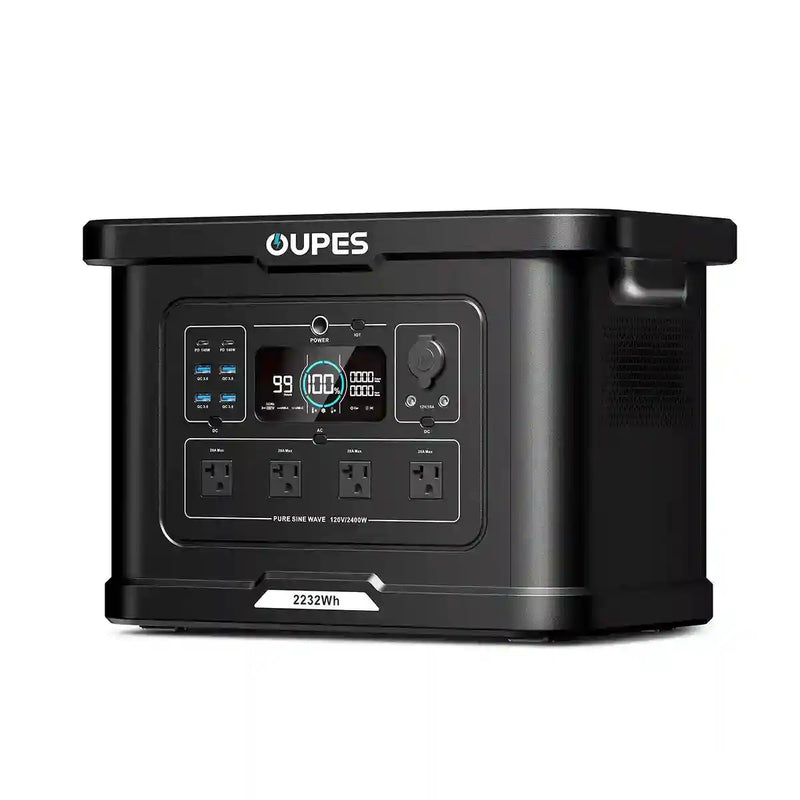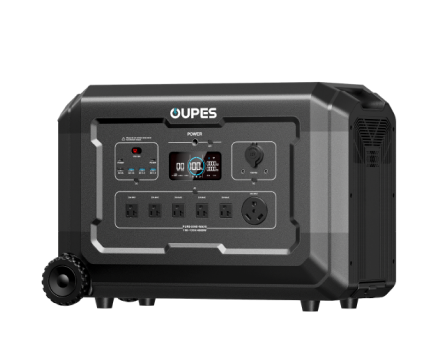
TL;DR / Key Takeaways
- A charged mobile power station keeps essentials—fridge, phones, medical devices—running safely indoors during outages.
- Size by capacity (Wh) for runtime and output (W) for what you can power at once.
- OUPES offers options from portable day-kits to expandable whole-home backup with fast AC + solar recharging.
- Plan for recharging: wall, car, solar panels, and (optionally) generator-charging for multi-day blackouts.
- Use UPS/EPS features for seamless backup of routers, computers, and critical electronics.
Why a Mobile Power Station Belongs in Every Hurricane Kit
Hurricanes can knock out power for hours or days. A mobile power station gives you quiet, indoor-safe electricity with no fumes, no routine maintenance, and simple one-button operation. Unlike traditional gasoline generators, battery power stations can be used inside to keep food safe, run communications, and power medical and work gear without worrying about carbon monoxide or pull-starts in a storm.
OUPES power stations use EV-grade LiFePO4 batteries with long lifespans (up to 3,500 cycles), robust Battery Management Systems (BMS), and features like fast charging, multi-port output, and—on select models—seamless UPS/EPS backup. They’re built for real-world emergencies, not just camping.
What to Look For: A Hurricane-Focused Buying Guide
Capacity (Wh) = How Long You Can Run Gear
Capacity measured in watt-hours (Wh) tells you runtime. As a simple rule of thumb: usable runtime ≈ (capacity × 0.85) ÷ device watts. The 0.85 factor accounts for inverter/transfer losses and is a practical planning estimate.
Output Power (W) & Surge
Output (continuous watts) determines what you can power simultaneously. Surge capacity covers brief startup spikes from devices like fridges or power tools. Match your station’s rated and surge power to your heaviest loads.
Safety, Battery Chemistry, and Backup
- Battery & BMS: OUPES LiFePO4 chemistry and advanced BMS add stability and longevity.
- UPS/EPS: Seamless switchover protects sensitive electronics. For example, Exodus 1200 offers EPS with <20 ms switchover, while Mega 5 supports seamless UPS backup (2100W Max).
Charging Flexibility
Storms can outlast one full battery. OUPES models support fast AC charging, solar charging, car charging, and combined AC + solar on select units for the quickest top-off. The more ways to recharge, the more resilient you are.
Portability & Noise
Battery stations are nearly silent—ideal at night and safe indoors. Consider weight and carrying design if you’ll move the unit between rooms or vehicles.
Which OUPES Power Station Fits Your Home?
Below is a quick, hurricane-oriented snapshot of popular OUPES options. Choose based on the devices you must run and how long you need them.
| Model | Rated Output | Surge | Capacity / Expandability | UPS / EPS | Ports | Fast Charge Highlights | Notes |
|---|---|---|---|---|---|---|---|
| Exodus 1200 | 1200W | 1500W boost Mode 3600W Surge | 992Wh Capacity | < 20 ms | 10 ports | Up to 600W AC, 240W solar, 840W AC+solar | Lightweight ~23 lbs; app control; great for essentials |
| Mega 2 | 2500W | 5400W | 2048Wh | < 20 ms | 15 ports | 1600W AC Charging + 2100W Solar Charging | Compact home backup & RV trips |
| Mega 3 | 3600W | 7000W | 3072Wh; expand up to 15.36kWh (with B2 units) | < 20ms | 16 ports | AC 1800W + Solar 2100W = 3900W combined | Primary home backup for most households |
| Mega 5 | 4000W | 7000W | 5040Wh,Expandable up to 45.36kWh (with B5) | Seamless UPS (2100W Max) | Up to 16 ports | < 20ms | Whole-home heavy duty; long outages |
| Titan 5 | 4000W | 7000W | 5040Wh | Seamless UPS Backup (2,200W Max) | 5 ports | Fully charge in 1.5 hours | Rugged outdoor & pro operations; also great backup |
Solar Panels & Extra Batteries (OUPES Ecosystem)
- 240W Solar Panel: High efficiency (up to 20%), ETFE multi-layer protection, MC4 connector for broad station compatibility.
- B2 Extra Battery: Can operate independently with multiple outputs (Anderson 12V/30A, DC5521, car lighter 12V/10A, dual 100W USB-C, four USB-A). Supports up to 2100W solar input and can fully charge in ~1.2 hours via solar alone—excellent in prolonged outages.
- B5 Extra Battery: Expand Mega 5 systems up to 45.36kWh for multi-day whole-home backup.
Scenario Playbooks for Hurricane Readiness
72 Hours Before Landfall
- Charge to 100%. Top off your OUPES station and extra batteries. If you have solar, stage panels indoors for a quick post-storm setup.
- Test critical loads. Plug in your fridge, router, CPAP, and lights. Confirm they run—and that startup surges don’t trip protection.
- Cable prep. Lay out heavy-gauge extension cords (short as practical), label which outlet powers which room or appliance.
- Data & network. Use EPS/UPS modes where available for routers and computers; verify switchover behavior.
- App & firmware. If your unit supports smart control, update firmware now (not during a storm).
During the Storm / Immediate Outage
- Indoor placement. Keep the unit above potential water ingress, on a flat, ventilated surface away from heat sources.
- Power budgeting. Prioritize the fridge, communications, medical devices, and a few LED lights. Avoid constant high-draw loads.
- UPS/EPS protection. With Exodus 1200 and Mega 5, your network and work devices can stay up through utility brownouts and short cuts.
After the Storm (Multi-Day Resilience)
- Solar recharge. Deploy OUPES 240W panels when it’s safe. Angle toward the sun; wipe dust/debris daily to maintain efficiency.
- Vehicle charging. Top up via 12V car port while driving for supplies.
- Expand capacity. Add B2/B5 batteries to stretch runtimes, or combine AC + solar on supported models for the fastest full recharge.
- Share power smartly. Help neighbors with quick top-offs (phones, radios) without depleting your reserved capacity for refrigeration and medical needs.
Runtime Planner: How Long Will It Run?
These are approximate runtimes using a practical 85% usability factor. Your actual results vary with temperature, device efficiency, and usage patterns (especially for cycling loads like refrigerators).
| Device | Mega 2 (2048Wh) | Mega 3 (3072Wh) | Titan 5 (5000Wh) |
|---|---|---|---|
| Refrigerator (avg 150W) | ≈ 11.6 hrs | ≈ 17.4 hrs | ≈ 28.3 hrs |
| CPAP (40W) | ≈ 43.5 hrs | ≈ 65.3 hrs | ≈ 106.2 hrs |
| Wi-Fi Router (12W) | ≈ 145.1 hrs | ≈ 217.6 hrs | ≈ 354.2 hrs |
| LED Bulb (10W) | ≈ 174.1 hrs | ≈ 261.1 hrs | ≈ 425.0 hrs |
| Laptop (60W) | ≈ 29.0 hrs | ≈ 43.5 hrs | ≈ 70.8 hrs |
| Box Fan (50W) | ≈ 34.8 hrs | ≈ 52.2 hrs | ≈ 85.0 hrs |
| Window AC (500W) | ≈ 3.5 hrs | ≈ 5.2 hrs | ≈ 8.5 hrs |
| Microwave (1000W) | ≈ 1.7 hrs | ≈ 2.6 hrs | ≈ 4.2 hrs |
Phone charges (≈15Wh each): Mega 2 ≈ 116 charges; Mega 3 ≈ 174 charges; Titan 5 ≈ 283 charges.
Tip: Keep the fridge door closed; it greatly extends runtime. Use LED lighting and fans instead of space heaters or high-draw appliances whenever possible.
Solar Recharging: Planning for Several Days Without Grid Power
Solar keeps you independent when the grid is down. OUPES 240W Solar Panels feature durable ETFE construction and MC4 connectors. As a rough estimate, each 240W panel can add several hundred watt-hours per day depending on sun hours and conditions. Multiple panels shorten recharge time dramatically.
| Panels | Good Sun (daily) | Use-Case |
|---|---|---|
| 1 × 240W | Top-ups for phones, routers, lights | Maintain communications & basics |
| 2–4 × 240W | Meaningful recharge for 2–5kWh units | Daily fridge + essentials |
| 6+ × 240W | Faster recovery on larger systems | Multi-day outages; partial whole-home |
If you need even more resilience, consider pairing supported stations with extra batteries (B2/B5). On compatible setups, combine AC + solar for the fastest turnaround between storms or during sporadic grid returns.
Step-By-Step: Your First Hurricane Power Drill
- List critical loads: fridge, router, phone chargers, two LED lamps, CPAP, and a fan.
- Pick your station:
- Small households & apartments: Exodus 1200 or Mega 2.
- Most family homes: Mega 3.
- Whole-home & extended outages: Mega 5 with B5 expansion; Titan 5 for rugged, high-demand use.
- Measure draw: Plug each device in and watch the station’s display. Record typical and peak watts.
- Practice switchover: Enable UPS/EPS where available; simulate an outage to confirm devices stay on.
- Stage solar: Test panel setup in the yard or balcony on a sunny day. Coil and label MC4 cables.
- Create a cord map: Label outlets for “Kitchen—Fridge,” “Office—Router,” etc., to avoid chaos in the dark.
Safety & Best Practices
- Keep the station dry and elevated. Use drip loops on cables to prevent water from running toward connectors.
- Avoid daisy-chaining power strips. Use heavy-gauge extension cords sized for load and distance.
- Don’t cover the unit; allow ventilation. High heat reduces performance.
- Follow your device’s medical guidance; consult professionals for life-critical equipment.
- Regularly cycle and top off batteries outside hurricane season to keep them healthy.
FAQ
Is a mobile power station safe to use indoors?
Yes. OUPES battery stations have no exhaust or gasoline fumes and are designed for indoor use. Keep vents clear and the unit dry.
How do I size my station?
List your must-run devices, add their watts, and ensure the station’s rated output exceeds that number. Then size capacity (Wh) for the hours of runtime you need.
Can I run a refrigerator?
Yes—match the station’s surge capability to the fridge’s startup spike. The runtime table above shows typical averages for planning.
What does EPS/UPS mean in practice?
EPS/UPS keeps devices running through short outages and brownouts. Exodus 1200 switches in under 20 ms; Mega 5 offers seamless UPS backup up to 2100W.
How fast can I recharge?
It depends on the model and inputs. For example, Mega 3 supports up to 3900W combined AC+solar, and Mega 5 can fully charge in about 1.3 hours with up to 3900W AC+solar. Exodus 1200 supports up to 600W AC, 240W solar, or 840W combined.
What about portable solar in cloudy weather?
You’ll still harvest energy, but at reduced rates. Using multiple OUPES 240W panels and keeping them clean & well-oriented improves yields.
Conclusion
Hurricanes are unpredictable, but your power plan doesn’t have to be. Choose an OUPES mobile power station sized for your needs, add solar and extra batteries for resilience, and practice your setup before a storm. With the right equipment and a simple drill, you’ll keep food cold, devices connected, and your household safer—no noise, no fumes, and far less stress.




























